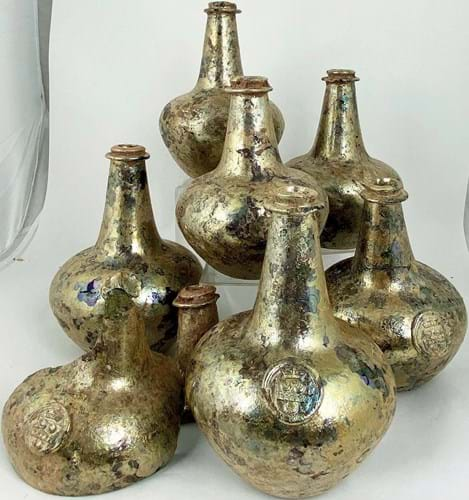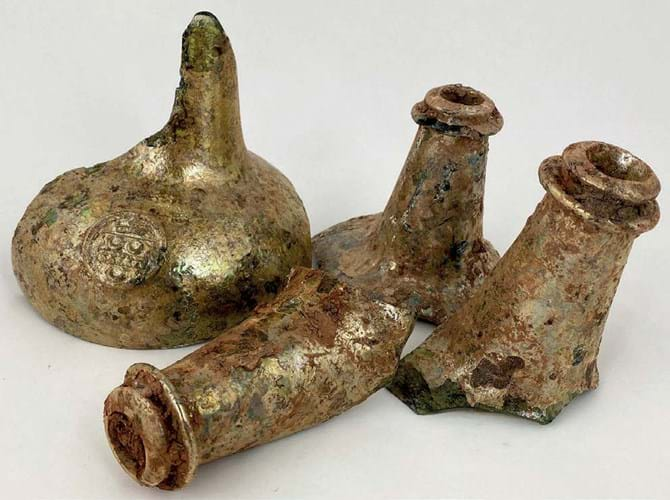
The six near-complete ‘shaft and globe’ type bottles c.1665-70 were discovered on a construction site less than a mile from the Croome estate, former home of Earls of Coventry.
Dug up in November 2019, the bottles have been entered for sale at specialist BBR Auctions in Elsecar, South Yorkshire, by the building firm that found them.
Alan Blakeman of BBR told ATG: “The JCB was digging a trench for footings. As the first ‘piece’ shone in the sunshine the workman stopped to see what it was. He pulled it out and the others were there to just pluck from the clay. It’s incredible they didn’t damage them.”
Seals on two bottles and a fragment bear Coventry arms surmounted by a ducal coronet – similar (but not identical) to another bottle in the Museum of London collection. Black glass wine bottles with seals carrying the arms, names, dates and places of former owners command a significant premium in the collecting arena.
There is a possibility that these survivors, al l with an iridescent ‘nature’s gilding’ patina associated with centuries underground, are connected with George Villiers (1628-87), the second Duke of Buckingham and second Earl of Coventry.

The seal of the Coventry arms surmounted by a ducal coronet found on two of the bottles offered at BBR.
The son of James I’s favourite courtier of the same name, Villiers was also the pioneering owner of three London glasshouses. His interests included the glassworks at Rutland House, Charterhouse Square in the City (now Glasshouse Yard), another factory in Greenwich and the Vauxhall glassworks in the area now called Glasshouse Walk.
The latter made plate and mirror glass (for which Villiers was granted an exclusive patent in 1663) and from c.1680 employed George Ravenscroft, inventor in the 1670s of a durable lead crystal glass.
Croome Court, now owned by the National Trust, was the seat of the Coventry family from the late 16th century with a Jacobean manor on the site until the current house and gardens were built by the 6th Earl in the mid-18th century.
Other candidates for the ownership and commission of the hoard are George 3rd Baron Coventry (1628-80) and Thomas, 1st Earl of Coventry of the second line (c.1629-99). Four of the six complete bottles are missing seals, offering the strong possibility that they were deliberately removed before burial.

This group of four neck fragments, including one with a seal, carries an estimate of £40-60 at BBR on February 2.
The hoard, valued by Blakeman at over £20,000, will be sold piecemeal across sales in February, April and June. Two near-complete 8in (20cm) bottles (both with missing seals) are estimated at £1000-2000 each on February 2 with a lot of neck fragments pitched at a modest £40-60.
The current auction record for a sealed bottle stands at £18,000 bid at BBR in 2018 for a shaft and globe with the seal GR and the date 1682. It had been bought as a copy a decade earlier for just £30.














